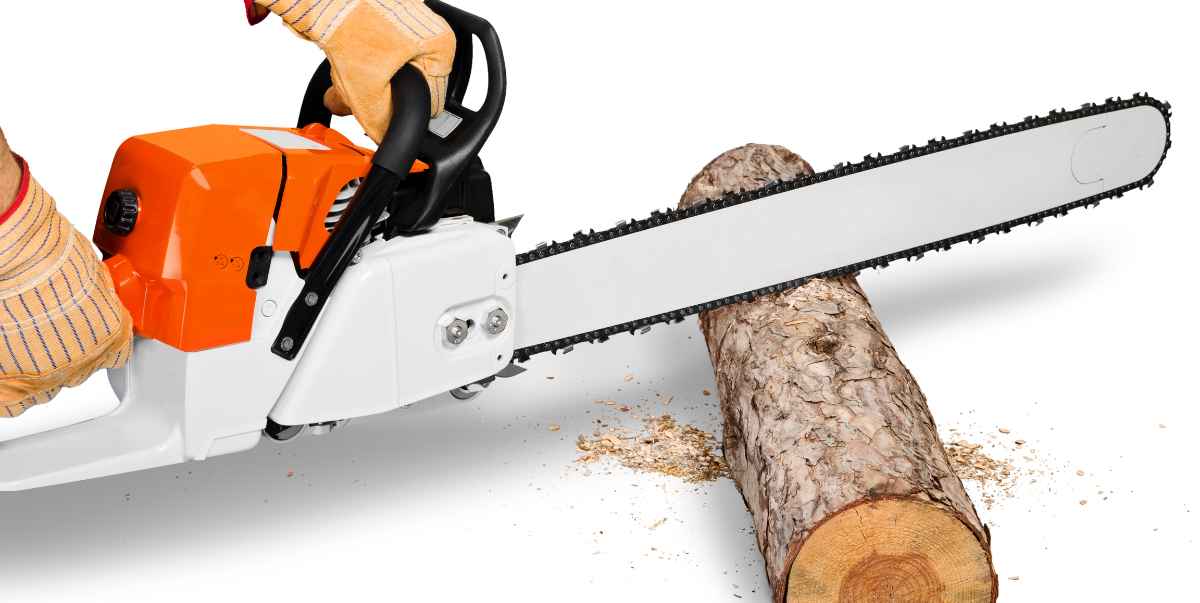To cut a log lengthwise with a chainsaw, carefully mark the desired cutting line on the log and use a guide rail or straight edge to ensure a straight cut. Position the chainsaw at one end of the log, start the chainsaw, and slowly guide it along the marked cutting line, applying consistent pressure.
Make sure to wear proper safety gear and take necessary precautions while operating the chainsaw. When it comes to cutting a log lengthwise with a chainsaw, there are key steps to follow. By marking the cutting line, using a guide rail, and employing a steady hand to apply consistent pressure, you can achieve a straight and accurate cut.
We will explore the process of cutting logs lengthwise using a chainsaw, along with useful tips for safety and efficiency. Whether you are a seasoned woodworker or a beginner looking to undertake your next DIY project, this guide will provide you with the necessary information to successfully cut logs lengthwise with a chainsaw.
Preparing For A Precise Longitudinal Cut
Slicing a log lengthwise with a chainsaw can be a challenging yet rewarding task. Whether you’re a woodworking enthusiast or need to split a log for firewood, efficient and accurate cuts are essential. In this guide, we’ll cover the necessary steps to prepare yourself and the equipment, ensuring a precise longitudinal cut. Our focus will be on selecting the right chainsaw blade for the job, examining the log and planning the cut, and ensuring safety measures and equipment for the task.
Selecting The Right Chainsaw Blade For The Job
Choosing the appropriate chainsaw blade is crucial for achieving a clean and smooth longitudinal cut. Different log sizes and densities require varying blade lengths, types, and teeth configurations. To ensure an optimized cutting experience, consider the following factors:
- Log thickness: A thicker log may require a longer chainsaw blade to cut through the entire length.
- Log hardness: Hardwoods like oak or hickory may demand a specialized blade designed for cutting dense materials.
- Teeth type: Some blades have aggressive teeth for efficient cutting, while others have finer teeth for smoother finishes.
- Blade sharpness: A sharp blade is essential for clean cuts and preventing kickbacks. Ensure your chainsaw blade is properly sharpened before starting the task.
Taking these aspects into account will help you determine the most suitable chainsaw blade for your specific needs.

Examining The Log And Planning The Cut
Before embarking on a longitudinal cut, it’s essential to thoroughly examine the log and plan your approach. This step minimizes potential issues and helps you achieve a precise and desired outcome. Consider the following guidelines:
- Inspect the log: Check for any irregularities, such as knots, branches, or nails embedded in the wood. These obstructions might affect the smoothness of your cut or damage your chainsaw blade. Make necessary adjustments, like removing nails or trimming branches, before commencing the cut.
- Measure and mark: Use a measuring tape to determine the desired length and mark it on the log. Double-check your measurements to avoid any inaccuracies. You can create a guiding line by connecting the marked points with a straight edge.
- Account for saw kerf: Keep in mind that the chainsaw blade will create a saw kerf, resulting in a slightly narrower cut. Consider this while measuring and marking, ensuring the final piece matches your intended dimensions.
By examining the log and planning the cut accordingly, you’ll be well-prepared to proceed with precision and efficiency.
Ensuring Safety Measures And Equipment For The Task
When working with a chainsaw, safety should always be a top priority. Taking the necessary precautions and using appropriate safety equipment will help prevent accidents and injuries. Here are some vital safety measures to keep in mind:
- Wear protective gear: Always wear protective equipment such as goggles, gloves, and a helmet with a face shield. Additionally, opt for chainsaw chaps or pants to shield your legs from potential kickbacks.
- Secure the log: Ensure the log is stable and properly supported during the cutting process. Use sawhorses or other sturdy supports to prevent any unexpected movements that could pose a safety hazard.
- Maintain a clear workspace: Remove any obstacles or debris that might hinder your movement or create tripping hazards. Maintain a clean work area for optimal safety.
- Make use of a chainsaw safety brake: Familiarize yourself with the safety brake on your chainsaw and activate it when not actively cutting. This feature significantly reduces the risk of accidents caused by chain rotation.
Prioritizing safety measures and equipment ensures a secure and stress-free cutting experience, allowing you to focus on achieving a precise and clean longitudinal cut.
Techniques For Mastering Longitudinal Cuts
When it comes to cutting a log lengthwise with a chainsaw, there are several techniques that can help you achieve clean and accurate cuts. Proper chainsaw handling and body positioning, setting up guide rails for maintaining a straight cut, and utilizing depth gauges for consistency in cut depths are crucial aspects to consider. By mastering these techniques, you can ensure safe and efficient log cutting with a chainsaw.
Proper Chainsaw Handling And Body Positioning
One of the most important aspects of cutting a log lengthwise is ensuring that you have proper chainsaw handling and body positioning. This not only ensures your safety but also helps in achieving accurate cuts.
Here are some key points to remember regarding proper chainsaw handling and body positioning:
- Maintain a firm grip on the chainsaw handle at all times.
- Position your body in a stable stance with your feet shoulder-width apart.
- Keep a comfortable distance between yourself and the log, ensuring that you have enough space to maneuver the chainsaw.
- Hold the chainsaw close to your body, keeping your elbows locked to maintain better control.
- Position yourself so that you have a clear view of the cutting area.
Setting Up Guide Rails For Maintaining A Straight Cut
To achieve a straight and precise cut along the length of the log, setting up guide rails can be extremely helpful. Guide rails provide stability and act as a reference for maintaining a straight line while cutting.
Here’s how you can set up guide rails for cutting a log lengthwise:
- Measure and mark the desired width of the log on both ends.
- Place the guide rails parallel to each other and align them with the marked lines.
- Ensure that the guide rails are securely fixed in place to prevent any movement during cutting.
- Rest the chainsaw’s guide bar on the guide rails and make sure it moves smoothly along the marked lines.
- Start the chainsaw and begin cutting, allowing the guide rails to guide the movement of the chainsaw along a straight path.
Utilizing Depth Gauges For Consistency In Cut Depths
In order to achieve consistent cut depths while cutting a log lengthwise, it is essential to utilize depth gauges. Depth gauges help maintain uniformity and ensure that each cut is of the desired depth.
Here’s how you can utilize depth gauges to achieve consistency in cut depths:
- Identify the desired depth for your longitudinal cut and adjust the depth gauge on your chainsaw accordingly.
- Regularly check and adjust the depth gauge as needed during the cutting process.
- Use regular intervals or markings on the log as reference points to ensure consistency in cut depths.
- Always monitor the depth gauge and make adjustments if you notice any deviations from the desired depth.
By implementing these techniques for mastering longitudinal cuts, you can make the process of cutting a log lengthwise with a chainsaw safer and more efficient. Remember to prioritize safety by wearing appropriate protective gear and following proper chainsaw usage guidelines.
Frequently Asked Questions On How To Cut A Log Lengthwise With A Chainsaw
Can You Chainsaw A Log Lengthwise?
Yes, you can chainsaw a log lengthwise. This process involves cutting the log along its length to create long, thin pieces. It’s important to use caution and follow safety guidelines when using a chainsaw for this purpose.
How Do You Split Logs Lengthwise?
To split logs lengthwise, follow these steps:
1. Position the log vertically on a sturdy surface.
2. Use a chainsaw or a maul and a splitting wedge for larger logs.
3. Make a precise cut along the length of the log, starting from the top.
4. Repeat the process, splitting the log into desired halves or quarters.
5. Exercise caution and wear protective gear while splitting logs.
How Do You Cut A Log Straight With A Chainsaw?
To cut a log straight with a chainsaw, carefully follow these steps:
1. Mark the desired cutting line using a chalk or marker.
2. Use a guide or straightedge to keep the chainsaw aligned while cutting.
3. Keep the chainsaw blade perpendicular to the log to ensure a straight cut.
4. Make slow and controlled cuts, adjusting as needed.
5. Always prioritize safety by wearing proper protective gear and knowing the chainsaw’s operating manual.
How Do You Cut A Tree Trunk Lengthwise?
To cut a tree trunk lengthwise, start by marking the desired line of cut. Use a chainsaw to carefully follow the marked line, cutting slowly and steadily. Ensure safety precautions, such as wearing protective gear and having a stable work surface.
Always consult a professional for large or difficult tasks.
Conclusion
To sum up, cutting a log lengthwise with a chainsaw can be a challenging task, but with the right knowledge and techniques, it becomes achievable. By following the step-by-step guide provided in this blog post, you can ensure safety and effectiveness while cutting logs for various purposes.
Remember to prioritize safety measures like wearing protective gear and maintaining proper control over the chainsaw. With practice and experience, you will master the art of cutting logs lengthwise with a chainsaw and achieve precise and impressive results. So, go ahead and put your newly acquired knowledge into action!


